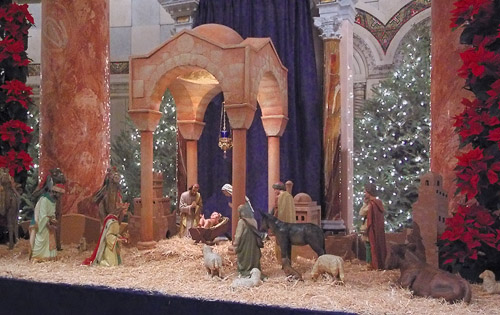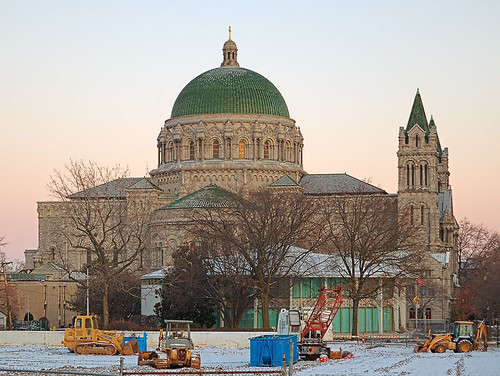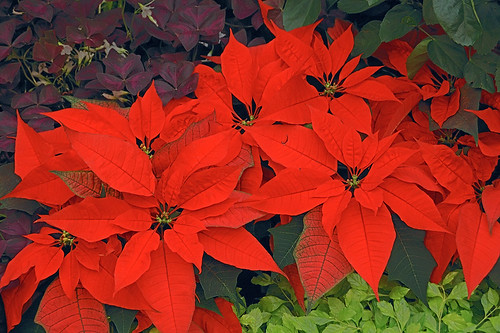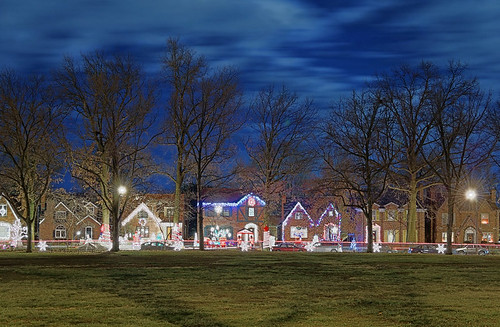O GOD, we praise Thee: we acknowledge Thee to be the Lord.
— from the Te Deum.
Praise and thanksgiving ought to be given not just for the good things of this past year, but also for the suffering, if it draws us closer to God.
Pages
▼
Thursday, December 31, 2009
Most Interesting Photos of 2009
ACCORDING TO the Flickr photo sharing website, these are my 20 most interesting photos of 2009. Some of these are my favorites, too.
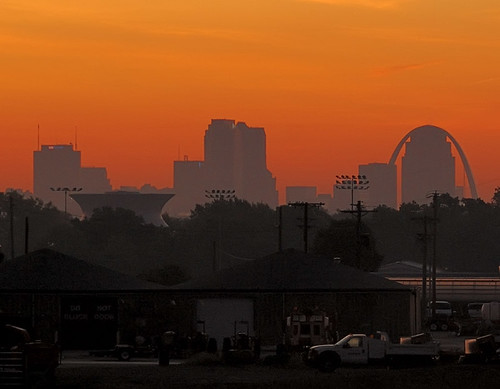
Downtown Saint Louis, taken just before sunrise.

Green foliage in the Climatron greenhouse, at the Missouri Botanical Garden.
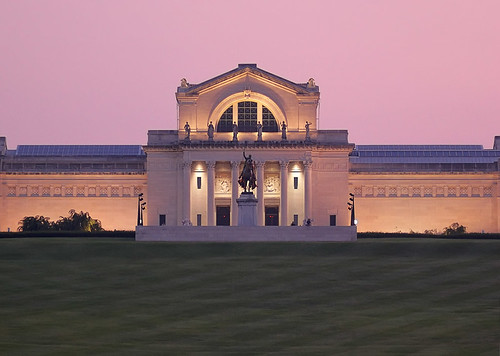
The Saint Louis Art Museum.
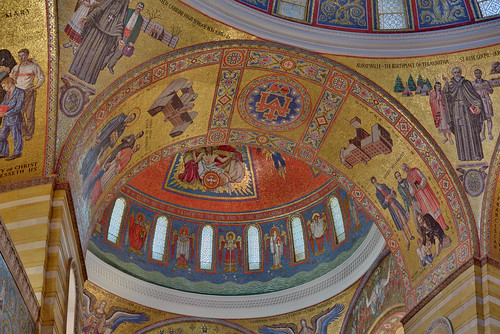
Detail of historical mosaics at the Cathedral Basilica of Saint Louis.
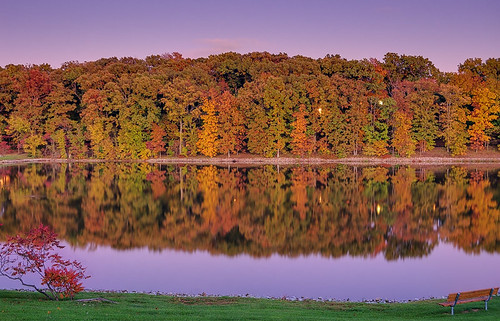
Lake Chesterfield at dusk.

Light from a stained glass window at Saint Peter Church, in Saint Charles, Missouri.

Heron at sunrise on the Missouri River.
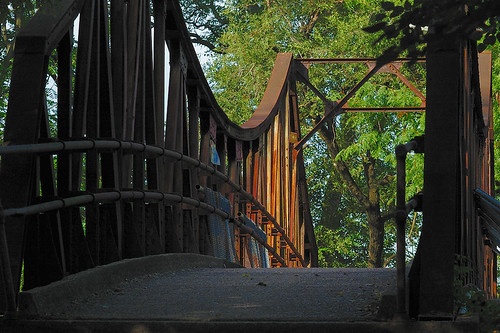
Bridge over railroad tracks in Forest Park.
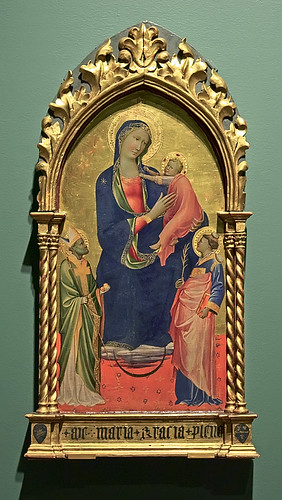
Madonna and Child with Saints Stephen and Nicholas, by Gherardo Starnina, at the Saint Louis Art Museum.
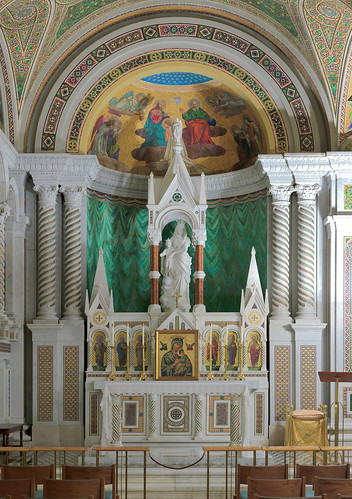
Our Lady's Chapel, at the Cathedral Basilica of Saint Louis.
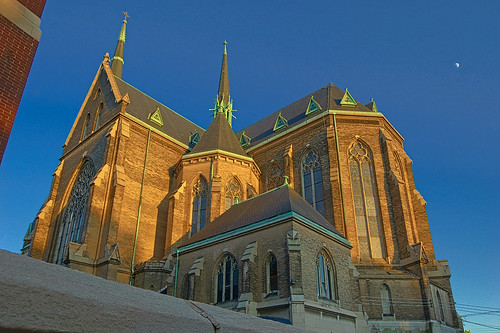
Saint Francis de Sales Oratory at sunset.
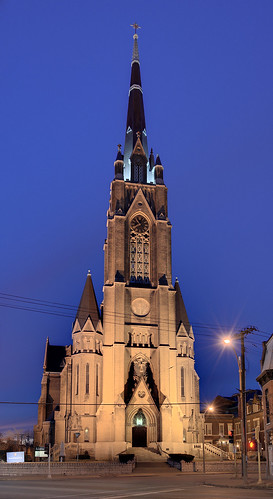
Saint Francis de Sales Oratory at night.
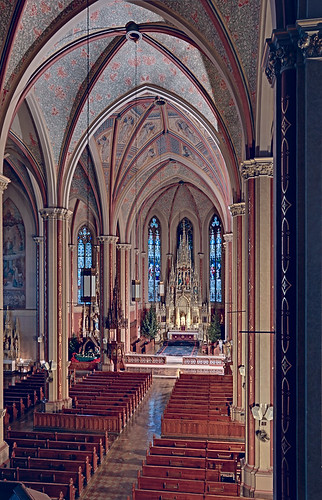
Nave of Saint Francis de Sales Oratory.

Mosaic ball with fleur de lis, by artist Robin Murez.
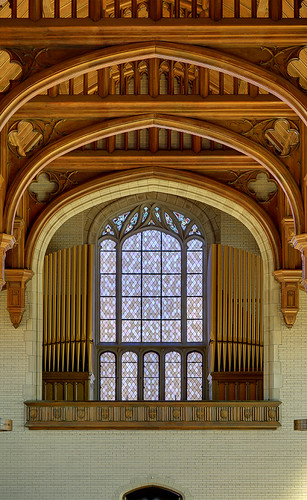
Former Daughters of Charity chapel at the University of Missouri - Saint Louis.
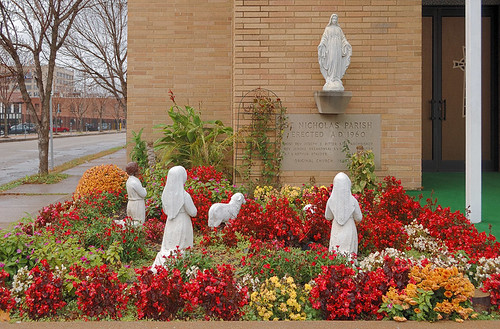
Saint Nicholas Church, in Saint Louis.
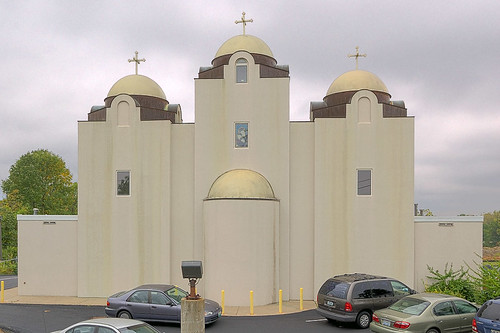
Saint Mary and Saint Abraam Coptic Orthodox Church.

Fall color at the Missouri Botanical Garden.
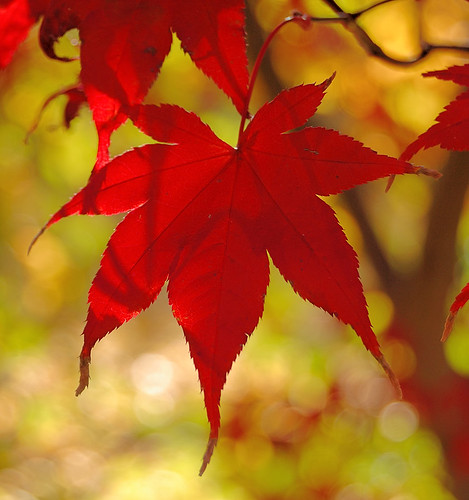
Red maple leaf at the Missouri Botanical Garden.
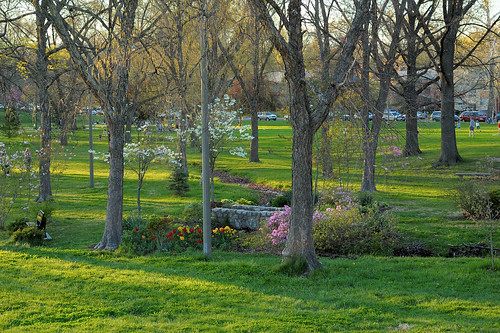
Tamm Avenue Spring in Francis Park.

Downtown Saint Louis, taken just before sunrise.

Green foliage in the Climatron greenhouse, at the Missouri Botanical Garden.

The Saint Louis Art Museum.

Detail of historical mosaics at the Cathedral Basilica of Saint Louis.

Lake Chesterfield at dusk.

Light from a stained glass window at Saint Peter Church, in Saint Charles, Missouri.

Heron at sunrise on the Missouri River.

Bridge over railroad tracks in Forest Park.

Madonna and Child with Saints Stephen and Nicholas, by Gherardo Starnina, at the Saint Louis Art Museum.

Our Lady's Chapel, at the Cathedral Basilica of Saint Louis.

Saint Francis de Sales Oratory at sunset.

Saint Francis de Sales Oratory at night.

Nave of Saint Francis de Sales Oratory.

Mosaic ball with fleur de lis, by artist Robin Murez.

Former Daughters of Charity chapel at the University of Missouri - Saint Louis.

Saint Nicholas Church, in Saint Louis.

Saint Mary and Saint Abraam Coptic Orthodox Church.

Fall color at the Missouri Botanical Garden.

Red maple leaf at the Missouri Botanical Garden.

Tamm Avenue Spring in Francis Park.
Highest Rated Posts of 2009
A MIXTURE OF your ratings and website statistics gives us this list of the most popular postings of the year 2009 at Rome of the West. After five years of blogging, I may have a vague idea of what kind of articles may invoke a lively response from readers, but there are always surprises.
A Walk Around Downtown Washington, Missouri
Photos of Corpus Christi Processions
Christmas Photos of the Cathedral Basilica of Saint Louis
Photos of Tower Grove Park
Photos of Pere Marquette State Park, in Grafton, Illinois
"Catholic Americana at its very best"
Photos from a Marian Exhibit at the Cathedral of Belleville
Photos of Saint Mary's (Immaculate Conception) Church, in Brussels, Illinois
Looks Familiar
A Walk Around Downtown Saint Louis, in the Rain
Photo of Saint Francis Xavier Church
Photos of the former Daughters of Charity Chapel at the University of Missouri - Saint Louis
Feast of the Annunciation
Photos of the Old Courthouse, in downtown Saint Louis, Missouri
Some Photos of Fountains
A Camera Diary
A Night at the Museum - Sacred Arts
The Clay Mines of Saint Louis
A Walk Along Grand Boulevard
Photos of Blessed Sacrament Church, in Belleville, Illinois
Photos of Old Saint Ferdinand Shrine, in Florissant, Missouri
Photos of Saint Mary and Saint Abraam Coptic Orthodox Church
Normandy, Missouri - the "Little Rome of the West", part 1
Photos of Old Saint Ferdinand Shrine, in Florissant, Missouri: Mother Duchesne's Convent
Photos of Saint Joseph Church, in Meppen, Illinois
A Walk Around Downtown Washington, Missouri
Photos of Corpus Christi Processions
Christmas Photos of the Cathedral Basilica of Saint Louis
Photos of Tower Grove Park
Photos of Pere Marquette State Park, in Grafton, Illinois
"Catholic Americana at its very best"
Photos from a Marian Exhibit at the Cathedral of Belleville
Photos of Saint Mary's (Immaculate Conception) Church, in Brussels, Illinois
Looks Familiar
A Walk Around Downtown Saint Louis, in the Rain
Photo of Saint Francis Xavier Church
Photos of the former Daughters of Charity Chapel at the University of Missouri - Saint Louis
Feast of the Annunciation
Photos of the Old Courthouse, in downtown Saint Louis, Missouri
Some Photos of Fountains
A Camera Diary
A Night at the Museum - Sacred Arts
The Clay Mines of Saint Louis
A Walk Along Grand Boulevard
Photos of Blessed Sacrament Church, in Belleville, Illinois
Photos of Old Saint Ferdinand Shrine, in Florissant, Missouri
Photos of Saint Mary and Saint Abraam Coptic Orthodox Church
Normandy, Missouri - the "Little Rome of the West", part 1
Photos of Old Saint Ferdinand Shrine, in Florissant, Missouri: Mother Duchesne's Convent
Photos of Saint Joseph Church, in Meppen, Illinois
Wednesday, December 30, 2009
“Save the Oratory’s Stained Glass Windows”
ONE OF THE stained glass windows at Saint Francis de Sales Oratory is damaged due to the unstable foundation of the church's tower.

From Tradition for Tomorrow:

From Tradition for Tomorrow:
One of the consequences of the shifting foundation of the church tower is the cracking in the masonry and the bowing of the historic stained glass windows of the church. The windows most seriously affected are the ones on the north side, on the right side of the choir loft. Unfortunately, the structural damage of the windows has reached a point where it is now necessary to remove the stained glass segments in order to save them.Click here to help.
At the Saint Louis University Museum of Art
AN EXHIBIT AT the Saint Louis University Museum of Art commemorates the 125th anniversary of the first Mass at Saint Francis Xavier, the University's grand church.
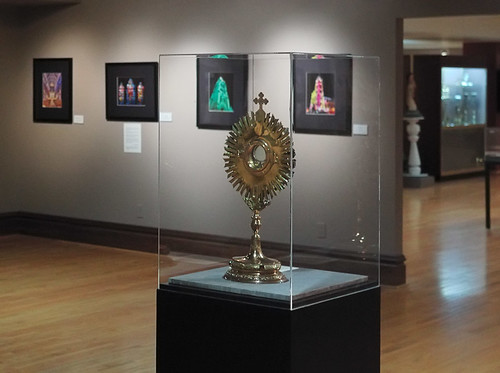
The exhibit, located on the third floor of the museum, features contemporary and historical photos of the church, as well as some liturgical vessels from the church. The exhibition is adjacent to the Collection of the Western Jesuit Missions.

Included in the exhibit is my photo of the nave of the church, taken on October 1st 2008.
The bright, yellowish incandescent lighting here is contrasted by the blue ‘transfigured’ light shining through the famed stained glass windows, which were designed by Emil Frei, Sr.
Here is the final image from which the print was made:
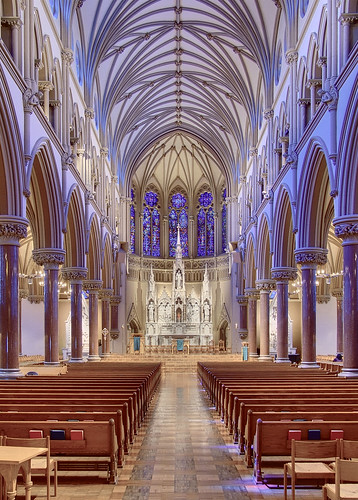
Many thanks to Fr. David Suwalsky, S.J., who selected this photo for the exhibition. The church's anniversary website is here, and special events will continue until October 2010. The museum is now closed for the winter break; click here to find more information.

The exhibit, located on the third floor of the museum, features contemporary and historical photos of the church, as well as some liturgical vessels from the church. The exhibition is adjacent to the Collection of the Western Jesuit Missions.

Included in the exhibit is my photo of the nave of the church, taken on October 1st 2008.
The bright, yellowish incandescent lighting here is contrasted by the blue ‘transfigured’ light shining through the famed stained glass windows, which were designed by Emil Frei, Sr.
Here is the final image from which the print was made:

Many thanks to Fr. David Suwalsky, S.J., who selected this photo for the exhibition. The church's anniversary website is here, and special events will continue until October 2010. The museum is now closed for the winter break; click here to find more information.
Photos of Saint Augustine Church, in Breese, Illinois
HERE ARE PHOTOS of Saint Augustine Church, in Breese, Illinois. The church is located in Clinton County, about 40 highway miles east of downtown Saint Louis in the Diocese of Belleville. Breese is home to another parish, Saint Dominic.
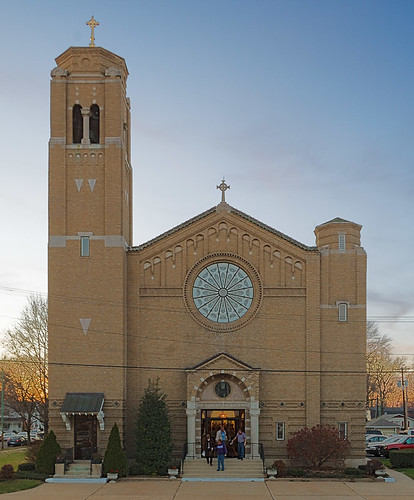
These photos taken on the eve of the first Sunday in Advent.
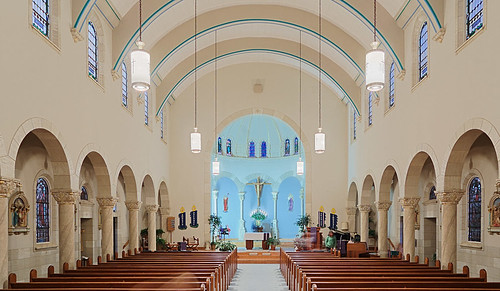
The parish dates from 1912, and this church from 1926.
Breese is located on the great Illinois prairie, and was first settled by Europeans in 1816. This area was on the Goshen Road, a historically significant and probably ancient path crossing the prairie. Large number of Germans came here starting in 1835, who devoted themselves to farming.
The town is named after lawyer and politician Sidney Breese, who lobbied for the construction of a railroad linking the Great Lakes and Mississippi Rivers. The railroad came to Breese in 1855, bisecting the newly laid-out town into northside and southside sections. As the population grew after the introduction of rail transport, a new parish was needed on the south side of town, leading to the founding of Saint Augustine.

Another view of the nave.
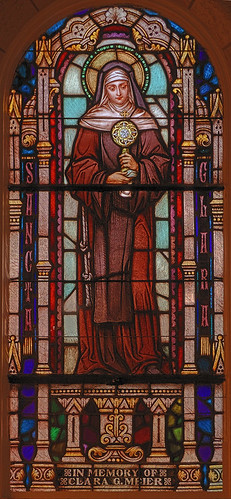
Sancta Clara
In memory of Clara G. Meier
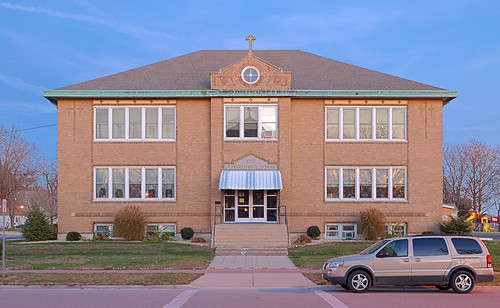
The school building. The parish is served by the consolidated All Saints Academy.
Click here for photos of other churches in Clinton County.
Address:
525 South Third Street
Breese, Illinois 62230

These photos taken on the eve of the first Sunday in Advent.

The parish dates from 1912, and this church from 1926.
Breese is located on the great Illinois prairie, and was first settled by Europeans in 1816. This area was on the Goshen Road, a historically significant and probably ancient path crossing the prairie. Large number of Germans came here starting in 1835, who devoted themselves to farming.
The town is named after lawyer and politician Sidney Breese, who lobbied for the construction of a railroad linking the Great Lakes and Mississippi Rivers. The railroad came to Breese in 1855, bisecting the newly laid-out town into northside and southside sections. As the population grew after the introduction of rail transport, a new parish was needed on the south side of town, leading to the founding of Saint Augustine.

Another view of the nave.

Sancta Clara
In memory of Clara G. Meier

The school building. The parish is served by the consolidated All Saints Academy.
Click here for photos of other churches in Clinton County.
Address:
525 South Third Street
Breese, Illinois 62230
Tuesday, December 29, 2009
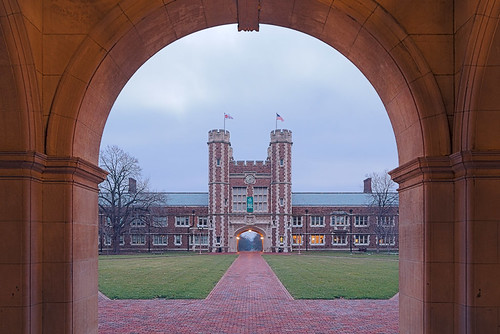
Brookings Hall, at Washington University in Saint Louis, taken this morning just before sunrise.
This English-style architecture reminds me that today is the feastday of Saint Thomas Beckett: click here to read of his martyrdom.
Photo of the Cathedral Basilica
Saturday, December 26, 2009
Feast of Saint Stephen, Protomartyr
ON THIS SECOND DAY of Christmas, we recall that the joy of the Nativity of Christ cannot be separated from the sorrow of the Cross of Christ. Today we commemorate the death of Deacon Stephen, the first martyr of the Church:
“You stiff-necked people, uncircumcised in heart and ears, you always oppose the holy Spirit; you are just like your ancestors. Which of the prophets did your ancestors not persecute? They put to death those who foretold the coming of the righteous one, whose betrayers and murderers you have now become. You received the law as transmitted by angels, but you did not observe it.”Saul was later known as Saint Paul after his dramatic conversion.
When they heard this, they were infuriated, and they ground their teeth at him. But he, filled with the holy Spirit, looked up intently to heaven and saw the glory of God and Jesus standing at the right hand of God, and he said, “Behold, I see the heavens opened and the Son of Man standing at the right hand of God.”
But they cried out in a loud voice, covered their ears, and rushed upon him together. They threw him out of the city, and began to stone him. The witnesses laid down their cloaks at the feet of a young man named Saul. As they were stoning Stephen, he called out, “Lord Jesus, receive my spirit.” Then he fell to his knees and cried out in a loud voice, “Lord, do not hold this sin against them”; and when he said this, he fell asleep.
Now Saul was consenting to his execution. On that day, there broke out a severe persecution of the church in Jerusalem, and all were scattered throughout the countryside of Judea and Samaria, except the apostles. Devout men buried Stephen and made a loud lament over him.
— Acts 7:51-8:2 (NAB)
Friday, December 25, 2009
Filius meus es tu
Dominus dixit ad me: Filius meus es tu, ego hodie genui te.
Merry Christmas!
The Lord hath said to me: Thou are My Son, this day have I begotten Thee.— Psalm 2, Introit for the First Mass at Midnight; the Feast of the Nativity of Our Lord.
Merry Christmas!
Thursday, December 24, 2009
December 24th
FROM THE LITURGY of the Hours for December 24th:
Awake, awake! Arise, O Jerusalem, You who drank at the LORD'S hand the cup of his wrath; Who drained to the dregs the bowl of staggering!
She has no one to guide her of all the sons she bore; She has no one to grasp her by the hand, of all the sons she reared!--
Your misfortunes are double; who is there to condole with you? Desolation and destruction, famine and sword! Who is there to comfort you?
Your sons lie helpless at every street corner like antelopes in a net. They are filled with the wrath of the LORD, the rebuke of your God.
But now, hear this, O afflicted one, drunk, but not with wine,
Thus says the LORD, your Master, your God, who defends his people: See, I am taking from your hand the cup of staggering; The bowl of my wrath you shall no longer drink.
I will put it into the hands of your tormentors, those who ordered you to bow down, that they might walk over you, While you offered your back like the ground, like the street for them to walk on.
Awake, awake! Put on your strength, O Zion; Put on your glorious garments, O Jerusalem, holy city. No longer shall the uncircumcised or the unclean enter you.
Shake off the dust, ascend to the throne, Jerusalem; Loose the bonds from your neck, O captive daughter Zion! ....
How beautiful upon the mountains are the feet of him who brings glad tidings, Announcing peace, bearing good news, announcing salvation, and saying to Zion, "Your God is King!"
Hark! Your watchmen raise a cry, together they shout for joy, For they see directly, before their eyes, the LORD restoring Zion.
Break out together in song, O ruins of Jerusalem! For the LORD comforts his people, he redeems Jerusalem.
The LORD has bared his holy arm in the sight of all the nations; All the ends of the earth will behold the salvation of our God.— Isaiah chapters 51, 52
Cleanse yourselves, sons of Israel, says the Lord; for tomorrow your Lord will come down, and he will take away from you all weaknesses.
Tomorrow the wickedness of the earth will be destroyed, and the Savior of the world will rule over us. And he will take away from you all weaknesses.— Responsory
Midnight Mass at the Oratory

Saint Francis de Sales Oratory was silent yesterday evening when I took this photo, but tonight the Institute of Christ the King Sovereign Priest will offer a glorious orchestral Midnight Mass. The Mass setting will be the Missa Solemnis in C, K.337, by Wolfgang Amadeus Mozart.
Festivities will start at 11:30 with Christmas carols, then Solemn High Mass at Midnight, followed by veneration of wood taken from the relic of the crib.
www.traditionfortomorrow.com
Wednesday, December 23, 2009
O Emmanuel
O Emmanuel, Rex et legifer noster, exspectatio Gentium, et Salvator earum : veni ad salvandum nos, Domine, Deus noster.
An acquaintance linked to a recording of the Advent song, O Come O Come Emmanuel, and remarked that the singer was Jewish. But how appropriate! Advent is a time of waiting for the coming of the Messiah, as Israel has done for thousands of years. This song recounts the seven “O” Antiphons of Advent, which are taken from the Old Testament book of Isaiah, and so is appropriate for Jew and Christian alike.
Ancient Israel had hope for a conquering Messiah, who would overthrow the enslavement of the great empires — although they also knew of the mysterious prophesy of the suffering servant. But Christians also wait for the same conquering Messiah — a return in glory of Christ the King who will rule the nations. So faithful Christians and Jews have the same eschatological hope. For a fascinating introduction to this, you may want to listen to audio lectures on the subject by Dr. Lawrence Feingold: click here. An essential key to unlocking the scriptures in this matter is the principle of typology, which was recognized by the ancient rabbis, but which is so often either ignored or inverted today.
We hope for the coming of the Messiah. But practical men dislike the concept of hope, who think it implies a foolish passivity. But consider its opposite: hopelessness is something so bad that only the most evil of men would desire to impose on their enemies. Hope is a theological virtue, not a practical one, although it remains essential as its opposite implies. As long as we put all our hope in worldly things, we remain dead in our sin; only if we wait in joyful hope for the coming of the Messiah, can we help make an icon of the heavenly kingdom here on earth.
O Emmanuel, king and lawgiver, desire of the nations, Savior of all people, come and set us free, Lord our God.— Great “O” Antiphon of the Canticle of Mary, for Vespers, on December 23rd.
An acquaintance linked to a recording of the Advent song, O Come O Come Emmanuel, and remarked that the singer was Jewish. But how appropriate! Advent is a time of waiting for the coming of the Messiah, as Israel has done for thousands of years. This song recounts the seven “O” Antiphons of Advent, which are taken from the Old Testament book of Isaiah, and so is appropriate for Jew and Christian alike.
Ancient Israel had hope for a conquering Messiah, who would overthrow the enslavement of the great empires — although they also knew of the mysterious prophesy of the suffering servant. But Christians also wait for the same conquering Messiah — a return in glory of Christ the King who will rule the nations. So faithful Christians and Jews have the same eschatological hope. For a fascinating introduction to this, you may want to listen to audio lectures on the subject by Dr. Lawrence Feingold: click here. An essential key to unlocking the scriptures in this matter is the principle of typology, which was recognized by the ancient rabbis, but which is so often either ignored or inverted today.
We hope for the coming of the Messiah. But practical men dislike the concept of hope, who think it implies a foolish passivity. But consider its opposite: hopelessness is something so bad that only the most evil of men would desire to impose on their enemies. Hope is a theological virtue, not a practical one, although it remains essential as its opposite implies. As long as we put all our hope in worldly things, we remain dead in our sin; only if we wait in joyful hope for the coming of the Messiah, can we help make an icon of the heavenly kingdom here on earth.
Tuesday, December 22, 2009
O Rex Gentium
O Rex Gentium, et desideratus earum, lapisque angularis, qui facis utraque unum: veni, et salva hominem, quem de limo formasti.
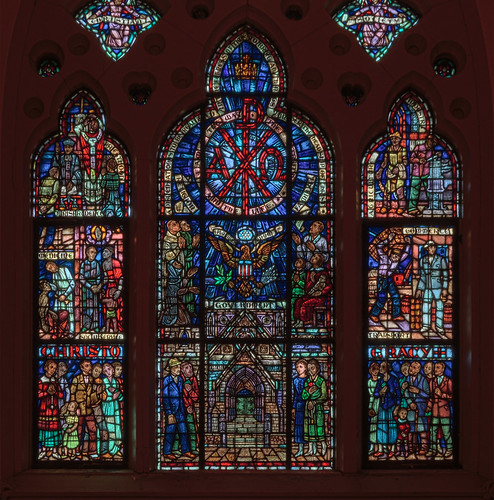
Christocracy window, at Saint Francis Xavier Church, in Saint Louis. Photo taken May, 2009.
All states have a kind of official spirituality or metaphysical philosophy, which we can deduce by observing the laws the state imposes on its subjects. While we cannot read the hearts of men, we can however read what intellectual and political leaders of a state say to their peers, which is often contradictory to what is claimed in the mass media. Are our nation's laws merely secular, or do they imply specific truth claims about the human person, nature, morality, and the role of the state?
The Messiah is king of all the nations, whether or not the nations recognize Him. The time of darkness is over, and the light of Gospel can illumine our hearts if we decide to let it in. Or we can do our own will and risk final judgement.
O King of all the nations, the only joy of every human heart; O Keystone of the mighty arch of man, come and save the creature you fashioned from the dust.— Great “O” Antiphon of the Canticle of Mary, for Vespers, on December 22nd.

Christocracy window, at Saint Francis Xavier Church, in Saint Louis. Photo taken May, 2009.
All states have a kind of official spirituality or metaphysical philosophy, which we can deduce by observing the laws the state imposes on its subjects. While we cannot read the hearts of men, we can however read what intellectual and political leaders of a state say to their peers, which is often contradictory to what is claimed in the mass media. Are our nation's laws merely secular, or do they imply specific truth claims about the human person, nature, morality, and the role of the state?
The Messiah is king of all the nations, whether or not the nations recognize Him. The time of darkness is over, and the light of Gospel can illumine our hearts if we decide to let it in. Or we can do our own will and risk final judgement.
Monday, December 21, 2009
Photos of Saint Francis of Assisi Church, in Aviston, Illinois
HERE ARE PHOTOS of Saint Francis of Assisi Church, in the village of Aviston, Illinois. The church is located approximately 36 road miles east of downtown Saint Louis, in Clinton County.
These photos were taken on the eve of the first Sunday in Advent.
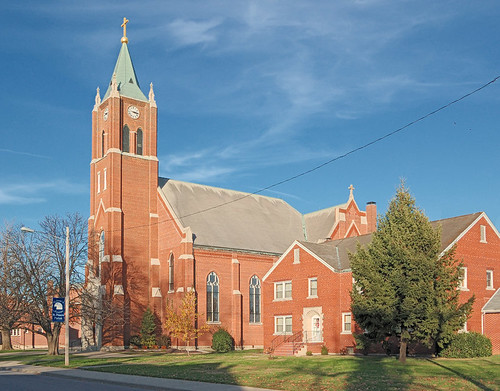
The late-afternoon sun illumines the church and rectory.
According to the history on the parish website:
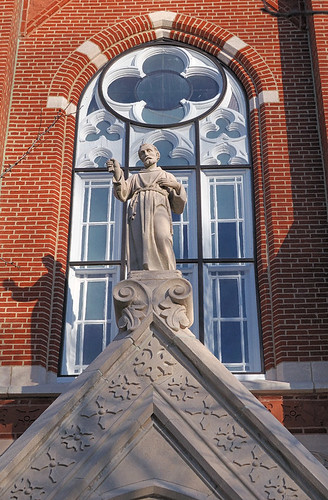
Statue of Saint Francis of Assisi over the front door.
Continuing the history:
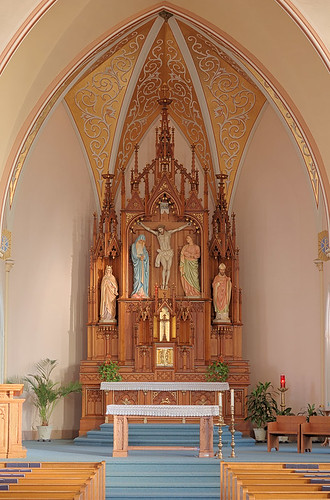
The high altar. Click here for another view.
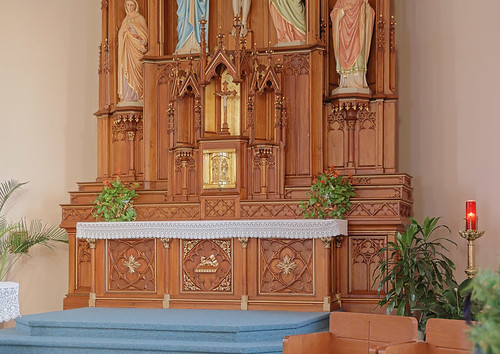
A closer view of the tabernacle.
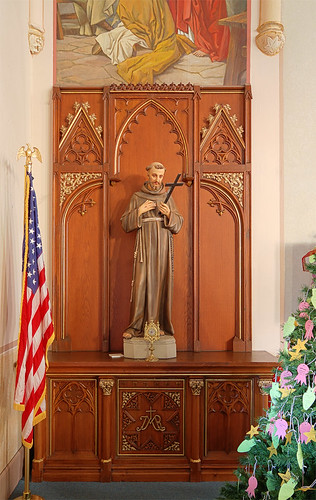
Altar of Saint Francis, with relic.
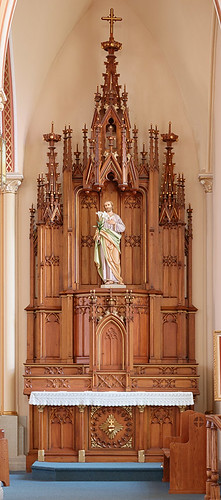
Altar of Saint Joseph.

Altar of the Blessed Virgin Mary, with stained glass window of the Annunciation.
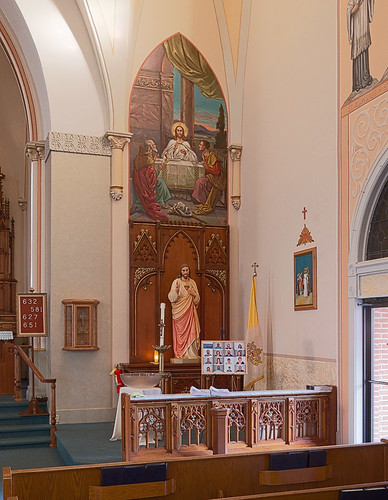
Altar of the Sacred Heart of Jesus is below a painting of Our Lord with the two disciples at Emmaus, who recognized Him at the breaking of the bread.
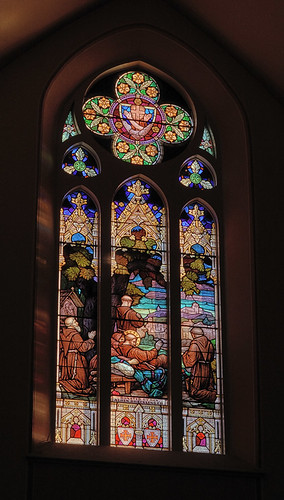
Stained glass window, which likely depicts the Transitus of Saint Francis. Francis blesses Assisi before his death.
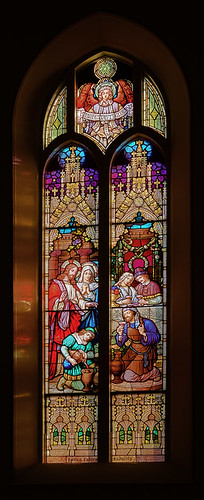
Window of the Wedding feast at Cana.
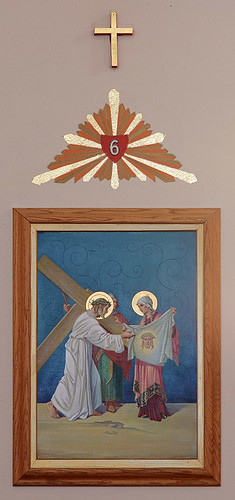
Sixth Station of the Cross: Jesus meets Veronica.

Saints Aloysius Gonzaga, John Vianney, and Isidore the Farmer.
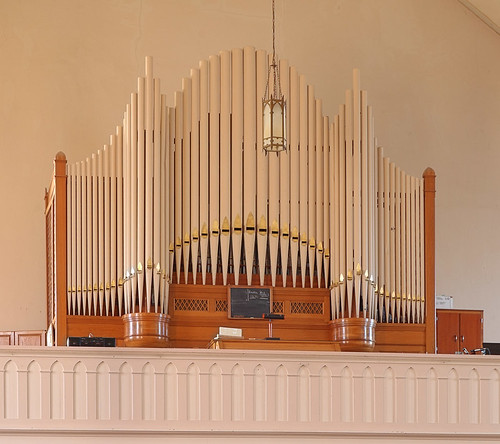
Pipe organ in the choir loft.
Click here for other photos of churches in Clinton County.
Mass times:
Sunday: 7:30am, 9:30am
Tuesday-Friday: 7:30am
Saturday: 7:30pm
Address:
251 South Clinton Street
Aviston, Illinois 62216
These photos were taken on the eve of the first Sunday in Advent.

The late-afternoon sun illumines the church and rectory.
According to the history on the parish website:
The first Catholic settlers in the territory of the present St. Francis Congregation of Aviston were emigrants from Northern Germany, Hanover, Westphalia, and Oldenburg. Among them were Bernard Huelsmann (1839), Diederich Overbeck (1841), Herman Henry Markus, Gerhard Feldmann (1848), Bernard Wempe, Henry Stroot, Henry Merscher, Herman Robbe, Carle Stuever (1849). They engaged in farming and by hard and persevering labor and by the practice of rigid economy converted the wild and weedy prairies of the region into rich and fertile farms.

Statue of Saint Francis of Assisi over the front door.
Continuing the history:
In the early 60’s the number of Catholic families had increased to such an extent that a movement for the erection of a church and the organization of a new parish was general...
Encouraged by their Bishop, the doughty pioneers, without the assistance of a priest, began to build their church in the Spring of 1864. A brick structure 80 by 50 feet was erected by Gerhard Rolfmeyer and Henry Dillmann, local contractors at a cost of $11,741.25. Owing to many difficulties caused by outside interference, lack of pastoral leadership, and shortage of labor, due to the war, the building was not completed until September, 1865...
The greatest undertaking of Father Lohmann at Aviston was the erection of the new church. As early as 1883, plans and specifications had been drawn by Henry Melcher, architect, of St. Louis, with the approval of the Bishop. According to these plans part of the old church was left standing and remodeled for the sanctuary and sacristies of the new church. To this was added to the west a transept 78 ft. wide, the nave, and a tower 185 ft. high, making the total length of the church 142 ft. Ground was broken on the site of the new church September 19, 1885, and the excavation of the basement, as well as the laying of the foundation, was completed before the end of the year. May 12, 1886, the general contract for the construction work was awarded to Henry Stoff and August Klutho, of Aviston...
St. Francis Church was solemnly consecrated by Bishop Janssen October 26, 1892.

The high altar. Click here for another view.

A closer view of the tabernacle.

Altar of Saint Francis, with relic.

Altar of Saint Joseph.

Altar of the Blessed Virgin Mary, with stained glass window of the Annunciation.

Altar of the Sacred Heart of Jesus is below a painting of Our Lord with the two disciples at Emmaus, who recognized Him at the breaking of the bread.

Stained glass window, which likely depicts the Transitus of Saint Francis. Francis blesses Assisi before his death.

Window of the Wedding feast at Cana.

Sixth Station of the Cross: Jesus meets Veronica.

Saints Aloysius Gonzaga, John Vianney, and Isidore the Farmer.

Pipe organ in the choir loft.
Click here for other photos of churches in Clinton County.
Mass times:
Sunday: 7:30am, 9:30am
Tuesday-Friday: 7:30am
Saturday: 7:30pm
Address:
251 South Clinton Street
Aviston, Illinois 62216
O Oriens
O Oriens, splendor lucis æternæ et sol iustitiæ: veni, et illumina sedentes in tenebris et umbra mortis.
The ancient Church saw the ages of man before the coming of the Messiah as times of darkness, while our age, the age of the Church, is a time of daybreak — the light of dawn has appeared in the skies, and we face towards the east awaiting sunrise, which represents the Messiah's return and final glory. Ancient churches themselves were oriented towards the east, with priest and faithful all facing eastward towards the coming Lord. Facing the east is a custom largely lost in the Catholic Church, and many — including Pope Benedict — think that we ought to recover this symbol of our Faith.
The sun, in its course through the seasons, is a natural symbol for higher things, which the Church reflects in her liturgies. The end of Advent happens to occur around the time of the winter solstice in the northern hemisphere, which marks the shortest day of the year, and so is a fitting symbol of the new light of Christ coming into the world.
Many critics say this kind of nature symbolism is pagan, and that Christian celebrations ought not be tied earthly events. But this kind of spiritualism has no place in the Church on earth, for God made the world and it was very good. Indeed, many of the spiritualistic critics themselves often descend into paganism, worshiping the solstice itself instead of Him who Made it.
O Radiant Dawn, splendor of eternal light, sun of justice: come, shine on those who dwell in darkness and the shadow of death.— Great “O” Antiphon of the Canticle of Mary, for Vespers, on December 21st.
The ancient Church saw the ages of man before the coming of the Messiah as times of darkness, while our age, the age of the Church, is a time of daybreak — the light of dawn has appeared in the skies, and we face towards the east awaiting sunrise, which represents the Messiah's return and final glory. Ancient churches themselves were oriented towards the east, with priest and faithful all facing eastward towards the coming Lord. Facing the east is a custom largely lost in the Catholic Church, and many — including Pope Benedict — think that we ought to recover this symbol of our Faith.
The sun, in its course through the seasons, is a natural symbol for higher things, which the Church reflects in her liturgies. The end of Advent happens to occur around the time of the winter solstice in the northern hemisphere, which marks the shortest day of the year, and so is a fitting symbol of the new light of Christ coming into the world.
Many critics say this kind of nature symbolism is pagan, and that Christian celebrations ought not be tied earthly events. But this kind of spiritualism has no place in the Church on earth, for God made the world and it was very good. Indeed, many of the spiritualistic critics themselves often descend into paganism, worshiping the solstice itself instead of Him who Made it.
Sunday, December 20, 2009
O Clavis David
O Clavis David, et sceptrum domus Israël, qui aperis, et nemo claudit, claudis, et nemo aperuit: veni, et educ vinctum de domo carceris, sedentem in tenebris, et umbra mortis.
Keys are symbols of power and authority, especially when they are keys to a royal palace, the gates of a walled city, or the keys to a prison.
Some sins become so habitual that they have the nature of imprisonment — consider the alcoholic or the compulsive and impoverished gambler: no longer do they get joy from drink or from the games. Rather they ruin their lives because they have little remaining choice in the matter: their vices compel them, like a slave is compelled by his master.
According to the prophets, the Messiah is the key which can unbind those imprisoned by sin, and which unlocks the gates to the kingdom of Heaven. Note how Christ gave the keys of the kingdom to Peter, who with the Apostles has the power to “bind and loose”, a reference to the chains which bind those in sin.
American culture often depicts Saint Peter as up in the clouds next to the pearly gates; this is boring at best. Rather, the Catholic view is that Peter — and his successors — have the keys to the kingdom in the here and now and not just the hereafter.
O Key of David, O royal Power of Israel controlling at your will the gate of Heaven: Come, break down the prison walls of death for those who dwell in darkness and the shadow of death...— Great “O” Antiphon of the Canticle of Mary, for Vespers, on December 20th.
Keys are symbols of power and authority, especially when they are keys to a royal palace, the gates of a walled city, or the keys to a prison.
Some sins become so habitual that they have the nature of imprisonment — consider the alcoholic or the compulsive and impoverished gambler: no longer do they get joy from drink or from the games. Rather they ruin their lives because they have little remaining choice in the matter: their vices compel them, like a slave is compelled by his master.
According to the prophets, the Messiah is the key which can unbind those imprisoned by sin, and which unlocks the gates to the kingdom of Heaven. Note how Christ gave the keys of the kingdom to Peter, who with the Apostles has the power to “bind and loose”, a reference to the chains which bind those in sin.
American culture often depicts Saint Peter as up in the clouds next to the pearly gates; this is boring at best. Rather, the Catholic view is that Peter — and his successors — have the keys to the kingdom in the here and now and not just the hereafter.
Photo of Immaculate Conception Church, in Park Hills, Missouri
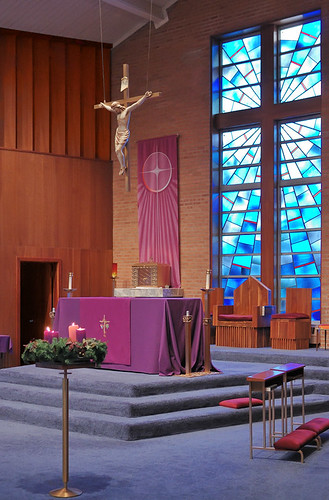
Sanctuary of Immaculate Conception Church, in Park Hills, Missouri; photo taken this morning, the fourth Sunday of Advent.
Located in Saint François County, the church is approximately 65 road miles south-by-southwest from downtown Saint Louis, and is in the historic Old Lead Belt mining district of the Ozark hills.
Many thanks to Tina of Snup's View from the Back Pew, who drove me here.
Saturday, December 19, 2009
O Radix Jesse
O Radix Jesse, qui stas in signum populorum, super quem continebunt reges os suum, quem gentes deprecabuntur: veni ad liberandum nos, iam noli tardare.
This is from Isaiah, chapter 11. Jesse was King David's father; the prophesy states that the lineage of Jessie would almost be destroyed, but not quite — the roots would remain from which will flower the Messiah.
In context, this passage tells that the Messiah shall bring justice to the poor, and slay the wicked. This is in contradiction to theologies of “health and wealth” and those that deny sin.
Jesus wasn't “nice”, although he was “meek and humble of heart”, and His return will be one of judgement and fire. Do we wait in joyful hope or in fear and trembling? Or rather, should we be trembling when instead we are comfortable with ourselves?
O Flower of Jesse’s stem, you have been raised up as a sign for all peoples; kings stand silent in your presence; the nations bow down in worship before you. Come, let nothing keep you from coming to our aid.— Great “O” Antiphon of the Canticle of Mary, for Vespers, on December 19th.
This is from Isaiah, chapter 11. Jesse was King David's father; the prophesy states that the lineage of Jessie would almost be destroyed, but not quite — the roots would remain from which will flower the Messiah.
In context, this passage tells that the Messiah shall bring justice to the poor, and slay the wicked. This is in contradiction to theologies of “health and wealth” and those that deny sin.
Jesus wasn't “nice”, although he was “meek and humble of heart”, and His return will be one of judgement and fire. Do we wait in joyful hope or in fear and trembling? Or rather, should we be trembling when instead we are comfortable with ourselves?
Friday, December 18, 2009
O Adonai
O Adonai, et Dux domus Israël, qui Moysi in igne flammæ rubi apparuisti, et ei in Sina legem dedisti: veni ad redimendum nos in bracchio extendo.
Who is your lord? In whom do you put your trust?
Do you put your faith in democracy, or in the invisible hand of the marketplace? Do you trust Caesar? Do you trust yourself? If so, your lord is a very small god.
Who voted for the creation of the galaxies? In what marketplace is the force of gravity traded? What congressional bill is responsible for the stars in the sky? Did you give birth to yourself, or do you make the air you breathe? Who is your lord?
O sacred Lord of ancient Israel, who showed yourself to Moses in the burning bush, who gave him the holy law on Sinai mountain: come, stretch out your mighty hand to set us free.— Great “O” Antiphon of the Canticle of Mary, for Vespers, on December 18th.
Who is your lord? In whom do you put your trust?
Do you put your faith in democracy, or in the invisible hand of the marketplace? Do you trust Caesar? Do you trust yourself? If so, your lord is a very small god.
Who voted for the creation of the galaxies? In what marketplace is the force of gravity traded? What congressional bill is responsible for the stars in the sky? Did you give birth to yourself, or do you make the air you breathe? Who is your lord?

